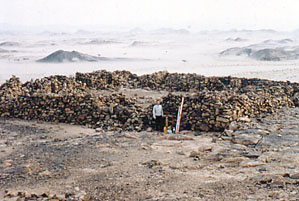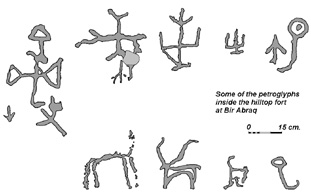|
The fort at Bir Abraq comprises a large enclosed
area, on the summit of a hill, with a number of structures inside, among
which this well preserved multi-room building:
|
|
Both inside and outside the fort at Bir Abraq petroglyphs
were discovered and copied. The petroglyphs outside the fort depict mainly
cattle, those inside look more like tribal markings:
|
|
|
|
|

|
|

|
|
|
|
|
|
|
|
|
Objective of visit:
|
|
To draw a measured plan of the site and study the surface
remains (including the ceramic finds). |
|
Date of visit:
|
|
- February 1995 |
|
Fellow visitors:
|
|
Eng. Brian Cannon (Berenike Project) and Mohamed Audid
(our Bedouin guide). |
| Results: |
|
A survey was performed using a theodolite and steel tape
measures. Off-site assistance was given by pottery expert Dr. Roberta Tomber
(Museum of London). No excavations took place. A full publication of the
results of our work can be found in Sidebotham SE, Zitterkopf RE. "Survey
of the hinterland"; in: Sidebotham SE, Wendrich WZ (eds.). Berenike
1995, report of the 1995 excavations at Berenike (Egyptian Red Sea coast)
and the survey of the Eastern desert. Leiden (CNWS) 1996: 372-77 (ISBN
90-73782-70-8). |
| Approximate position and date
of the site: |
|
The fort at Bir Abraq is in the far south of the Egyptian
Eastern desert, just north of the Sudanese border. Surface pottery dated
to the Ptolemaic period (ca. 330 - 30 BC). |
| Short description of the site: |
|
The function of the fort in Bir Abraq is somewhat enigmatic
although the large number of petroglyphs, depicting cattle, camels and
elephants, suggests that the fort somehow accommodated the transport of
these animals. |
| Additional remarks: |
|
Just north of the fort is a modern well which most likely
was also active when the fort was operational. Our work was sponsored by
the Berenike Project and private donors. |
| HOME |
|
|
 |
|
|